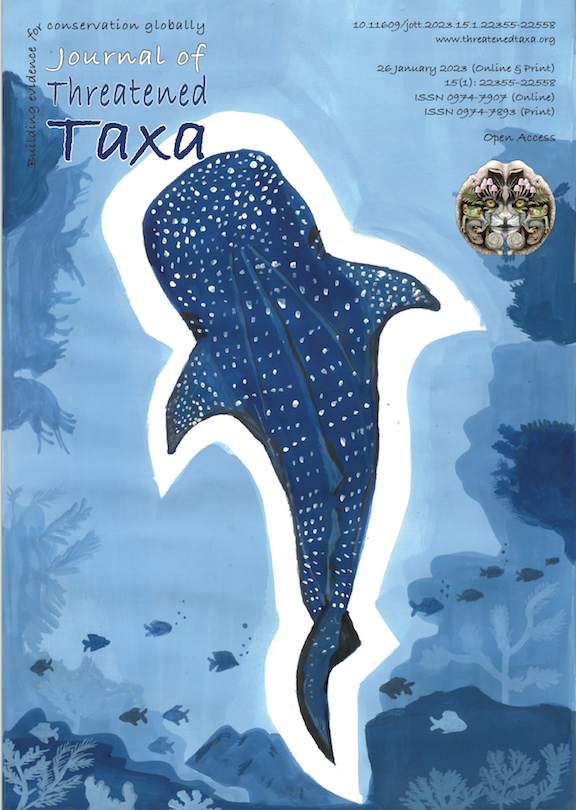Installation of hot boxes for conservation in the last nursery roost of Greater Horseshoe Bats Rhinolophus ferrumequinum in Austria
Main Article Content
Abstract
The Greater Horseshoe Bat Rhinolophus ferrumequinum has experienced drastic population declines in Austria over the last decades. Several central European countries harbor only residual isolated populations, often at the brink of extinction. Consequently, conservation efforts are undertaken to improve roosting, hibernation, and foraging conditions. One of these measures, although almost unheard of in international literature, is the installation of hot boxes in maternity roosts to improve thermal conditions during gestation and development of the young and provide roosting locations covering a range of different temperature regimes. Here, we report the first installation of hot boxes as a conservation effort for bats in Austria. Through this measure, conditions in the attic of Schloss Eggenberg in Graz, the last known maternity roost of Greater Horseshoe Bats in Austria, should be maintained and hopefully even improved to conserve this last Austrian breeding population in the long run.
Article Details

This work is licensed under a Creative Commons Attribution 4.0 International License.
Authors own the copyright to the articles published in JoTT. This is indicated explicitly in each publication. The authors grant permission to the publisher Wildlife Information Liaison Development (WILD) Society to publish the article in the Journal of Threatened Taxa. The authors recognize WILD as the original publisher, and to sell hard copies of the Journal and article to any buyer. JoTT is registered under the Creative Commons Attribution 4.0 International License (CC BY), which allows authors to retain copyright ownership. Under this license the authors allow anyone to download, cite, use the data, modify, reprint, copy and distribute provided the authors and source of publication are credited through appropriate citations (e.g., Son et al. (2016). Bats (Mammalia: Chiroptera) of the southeastern Truong Son Mountains, Quang Ngai Province, Vietnam. Journal of Threatened Taxa 8(7): 8953–8969. https://doi.org/10.11609/jott.2785.8.7.8953-8969). Users of the data do not require specific permission from the authors or the publisher.
References
Berthinussen, A., O.C. Richardson & J.D. Altringham (2014). Bat Conservation: Global evidence for the effects of interventions. Pelagic Publishing, Exeter, 87 pp.
Dietz, C. & A. Kiefer (2014). Die Fledermäuse Europas. Kennen, bestimmen, schützen. Kosmos (Kosmos-Naturführer), Stuttgart, 262pp.
Dietz, C. & I. Dietz (2021). Wärmeglocken für Wochenstuben des Großen Mausohrs (Myotis myotis) – ein Erfahrungsbericht. - Nyctalus 19(4–5): 428–444.
Froidevaux, J.S., K.L. Boughey, K.E. Barlow & G. Jones (2017). Factors driving population recovery of the greater horseshoe bat (Rhinolophus ferrumequinum) in the UK: implications for conservation. Biodiversity and Conservation 26(7): 1601–1621. https://doi.org/10.1007/s10531-017-1320-1
Leitl, R. (2021). Wärmeglocken als wichtiger Artenschutzbeitrag für die letzte deutsche Kolonie der Großen Hufeisennase (Rhinolophus ferrumequinum) im „Fledermaushaus Hohenburg“. Nyctalus 19(4–5): 420–427.
Matthäus, L., K. Kugelschafter & J. Fietz (2022). Evaluation of different monitoring methods at maternity roosts of greater mouse-eared bats (Myotis myotis). Biodiversity and Conservation 1–24. https://doi.org/10.1007/s10531-022-02389-7
Piraccini, R. (2016). Rhinolophus ferrumequinum. In: 2016 The IUCN Red List of Threatened Species: e.T19517A21973253. Accessed on 31 July 2022. https://doi.org/10.2305/IUCN.UK.2016-2.RLTS.T19517A21973253.en
Pysarczuk, S. (2008). Erstnachweis einer Großen Hufeisennase, Rhinolophus ferrumequinum (SCHREBER 1774) (Chiroptera, Rhinolophidae) in Oberösterreich. Beiträge zur Naturkunde Oberösterreichs 18: 305–308.
Ransome, R. (1973). Factors affecting the timing of births of the greater horseshoe bat (Rhinolophus ferrumequinum). Periodicum Biologorum 75: 169–175.
Ransome, R. & T. McOwat (1994). Birth timing and population changes in greater horseshoe bat colonies (Rhinolophus ferrumequinum) are synchronized by climatic temperature. Zoological Journal of the Linnean Society 112: 337–351.
Ransome, R. & A.M. Hutson (2000). Action plan for the conservation of the greater horseshoe bat in Europe (Rhinolophus ferrumequinum). Council of Europe No. 109: 18–104.
Spitzenberger, F. (2001). Die Säugetierfauna Österreichs. —Grüne Reihe des Bundesministeriums für Land- und Forstwirtschaft, Umwelt und Wasserwirtschaft. Bd. 13., Wien, 1–895pp.
Spitzenberger, F. (2005). Rote Liste der in Österreich gefährdeten Säugetierarten (Mammalia). In: Zulka K.P. (eds.). Rote Listen gefährdeter Tiere Österreichs. Grüne Reihe des Lebensministeriums Band 14/1: 45–62 pp.
Spitzenberger, F., E. Weiss & P. Sackl (2010). Massive population decline of the Critically Endangered Greater Horseshoe Bat, Rhinolophus ferrumequinum (SCHREBER 1774), in Styria, south Eastern Austria, between the mid 1990s and 2009 (Mammalia, Chiroptera). Joannea Zoologie 11: 5–17.
Van der Meij, T., A.J. Van Strien, K.A. Haysom, J. Dekker, J. Russ, K. Biala, Z. Bihari, E. Jansen, S. Langton, A. Kurali, H. Limpens, A. Meschede, G. Petersons, P. Presetnik, J. Prüger, G. Reiter, L. Rodrigues, W. Schorcht, M. Uhrin & V. Vintulis (2015). Return of the bats? A prototype indicator of trends in European bat populations in underground hibernacula. Mammalian Biology 80(3): 170–177. https://doi.org/10.1016/j.mambio.2014.09.004
Wright, P.G.R., T. Kitching, R. Hanniffy, M. Bollo Palacios, K. McAney & H. Schofield (2022). Effect of roost management on populations trends of Rhinolophus hipposideros and Rhinolophus ferrumequinum in Britain and Ireland. Conservation Evidence Journal 19: 21–26. https://doi.org/10.52201/CEJ19BUJS9747
Zingg, P.E., U. von Weissenfluh & M. Schaub. (2022). A small, heated roost facilitates nursery establishment and increases the size of a Lesser Horseshoe Bat (Rhinolophus hipposideros) colony in the northern Swiss Alps. Conservation Evidence Journal 19: 27–34. https://doi.org/10.52201/CEJ19MQMS5514

